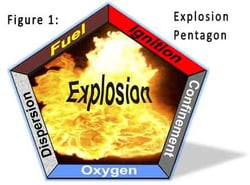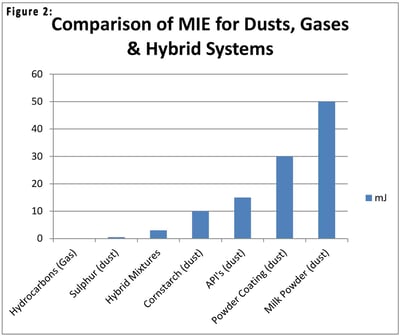Combustible Dust and Flash Fire Lessons: Taiwan Water Park Fire
By Jeff Griffin, Fauske & Associates
For those in industry, the dangers of combustible/hazardous dust have been increasingly high-profile. Leadership at the Chemical Safety Board (CSB) has spoken recently about the importance of adopting a consensus standard so that there is a more uniform approach to combustible dust safety.
Last week’s terrible accident in Taiwan illustrates that there is still a real lack of understanding about the dangers of dust explosions. The BBC reports that “a coloured powder ignited when it was dispersed into the crowd.”[i] More than 500 people were injured because the powder was ignited by something as simple as a cigarette. While this event was serious – it was not a combustible/hazardous dust explosion. It was a flash fire. This blog defines how dust can manifest as an explosion hazard or in a flash fire, and then identifies two key steps necessary to prevent both.
Understanding Confinement and Combustible Dust
 Many people are familiar with the explosion pentagon, which illustrates the five factors needed to have a combustible dust explosion, namely, fuel, ignition, dispersion, confinement, and oxygen. However, oftentimes, the dangers of dust explosions are not considered because people presume that a lack of confinement means that they are safe. This is just not true. A lack of confinement of a dust means that the explosive pressure generated by a material dissipates to the environment. This is good for preventing an explosion event, but it is still possible for a flash fire to occur even if there is no containment.
Many people are familiar with the explosion pentagon, which illustrates the five factors needed to have a combustible dust explosion, namely, fuel, ignition, dispersion, confinement, and oxygen. However, oftentimes, the dangers of dust explosions are not considered because people presume that a lack of confinement means that they are safe. This is just not true. A lack of confinement of a dust means that the explosive pressure generated by a material dissipates to the environment. This is good for preventing an explosion event, but it is still possible for a flash fire to occur even if there is no containment.
What is a Flash Fire?
Short Definition: The rapid burning of a material that is suspended in air. This could be a dust, a gas, a vapor, or a mixture of any one of these materials (we will discuss the danger of mixed or ‘hybrid’ systems later in this post). These types of incidents are quite common because they can happen with even very small amounts of material. This means that the injuries resulting from these events are often not as serious – and may not be reported in statistics. The Taiwan incident is a great example of how dangerous they can be. Another example occurred in the US in 2012.
Example: US Ink
The Taiwan incident is not the first time a colored powder has ignited in a combustible cloud. One notable example is the US Ink incident in 2012.[ii] In this case, it injured seven workers. While there wasn’t an explosion, the event was sufficient enough to warrant an investigation by the Chemical Safety Board (CSB) and for OSHA to fine the company nearly $221k. This event illustrates two key steps before handling combustible/hazardous dusts, and offers an important lesson about hybrid systems.
Step 1: Know your Dust
When dealing with any type of organic or metal dust, it is important to know whether or not it is combustible. Without test data about the specific material in your facility, it is hard to know what risks you are facing. In some cases, published literature is available about some materials. While this information may be a helpful guide, it is not sufficient to understand the risk or to be used for engineering purposes. The whole point of NFPA 652, the proposed new Standard on Combustible Dusts,[iii] is to provide for a unified approach to managing dusts, from the testing phase to implementing safety protocols. After testing your dust to know the characteristics, the next step is controlling ignition sources to prevent those conditions from happening.
Step 2: Controlling Ignition Sources
If a dust is combustible, it is important to control potential ignition sources. This event illustrates a concept that I was just teaching about during an on-site visit to a customer site. This particular facility had excellent housekeeping procedures, and dust collection equipment to prevent accumulation in the facility. However, there were several operations where material was being dumped into bags, or where the material had the potential to be suspended in air if a barrel was accidently dropped. While this facility was clean – there were still ignition sources present – including open electrical outlets and equipment that was not appropriately bonded and grounded (for more information on bonding and grounding, see our upcoming post in July 2015). The testing results indicated that several materials being handled had low Minimum Ignition Energies (MIE’s). Even though there were some engineering controls in place, they were not sufficient to prevent a spark that could ignite the dust. Given the right conditions, these materials could be easily ignited, just like the dust in the Taiwan disaster.
Final Lesson: The Danger of Hybrid Systems
 A final lesson from the Taiwan event concerns the danger of hybrid systems. Reports of the fire suggested that the dust was suspended in air along with a petroleum-based gas from a fog machine. If this is true, the combination could have impacted the ignition level needed to set off the suspended dust. Our experts have seen this behavior in both the lab and in the field. Sometimes, a process has operated safely for many years because it is only a vapor or powder system. Then, some accident or process change results in the two materials being suspended together. This results in a hybrid system, which requires much less energy to ignite than the dust material by itself. This is illustrated in Figure 2 (please note that these values are given as examples only).
A final lesson from the Taiwan event concerns the danger of hybrid systems. Reports of the fire suggested that the dust was suspended in air along with a petroleum-based gas from a fog machine. If this is true, the combination could have impacted the ignition level needed to set off the suspended dust. Our experts have seen this behavior in both the lab and in the field. Sometimes, a process has operated safely for many years because it is only a vapor or powder system. Then, some accident or process change results in the two materials being suspended together. This results in a hybrid system, which requires much less energy to ignite than the dust material by itself. This is illustrated in Figure 2 (please note that these values are given as examples only).
Conclusion
The event in Taiwan is a sobering reminder of the dangers that exist when handling any type of organic dust. While nearly every industry has been impacted in some way by combustible/hazardous dust, accidents are still occuring. Moving forward, it is important to recognize the fire and explosion hazards associated with dusts. The best way to do this is to take the steps prescribed by the NFPA and other regulatory organizations. Only by testing and understanding the characteristics of a dust can you effectively take steps to control the risks.
Jeff Griffin is the Director of Sales and Business Development for Fauske & Associates. His work brings him on-site to facilities in North America. He works with an expert team of consultants who provide on-site support to assess the risks associated with combustible/hazardous dusts. These experts sit on several key NFPA committees. Fauske & Associate also has one of the premier labs for dust and flammability testing in North America. Contact Jeff at griffin@fauske.com, 630-887-5278
[i] http://www.bbc.com/news/world-asia-33300970
[ii] http://www.csb.gov/csb-names-poor-design-and-failure-to-test-dust-collection-system-among-causes-of-us-ink-new-jersey-flash-fire-that-burned-seven-workers-in-2012-osha-again-urged-to-issue-new-combustible-dust-regulations-/
[iii] http://www.nfpa.org/codes-and-standards/document-information-pages?mode=code&code=652
